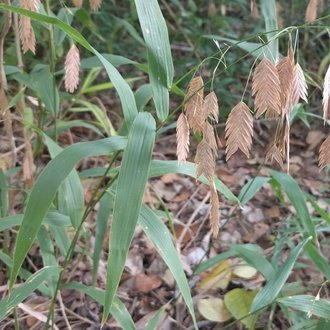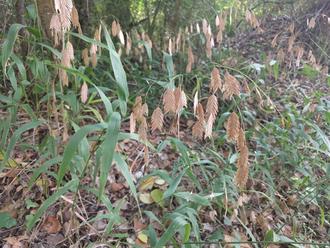Northern Sea Oats (Chasmanthium latifolium (Michx.) Yates)
Also known as woodland oats, Indian woodoats, woodoats, inland sea oats, river oats, inland oats; also classified as Uniola latifolia.
↑Summary
A perennial grass common in the southeastern and south-central U.S., becoming less common towards the northern limit of its range. Many northern populations are considered locally-endangered or threatened.
The common names reference a superficial resemblance to oats (Avena sp.) in appearance, due both to height and growth habit, and to the large, drooping seedheads; although both this species and oats are grasses, they are not closely related within the grass family, being placed in separate subfamilies. The other names reference the fact that this species is often found in woodlands near rivers, and the fact that it is related to Seaoats (Uniola paniculata) and resembles it in many respects.
↑Range - Expand
| Legend | Color |
| Native or Not Present | |
| Native | |
| Expanded | |
| Native or Expanded |
This tentative map is based on our own research. It may have limited data on Canada and/or Mexico, and there is some subjectivity in our assignment of plants as introduced vs. expanded. Read more in this blog post.
Although this plant occurs somewhere in each of these regions, it may only occur in a small part of some or all of them.
This species is increasingly used in landscaping nowadays, and it frequently escapes cultivation and establishes in the wild, although it spreads slowly. We marked new populations in Nebraska and Wisconsin expanded because of the proximity to its native range, but the one in Wisconsin is far enough that it could also probably be considered introduced. Time will tell if this species spreads to fill gaps in these new parts of its range.
↑Habitat
Mostly open woodlands, especially along streams and rivers or near water. Prefers part-sun in well-drained but moist, loamy or rocky soils. Absent from heavily-shaded woods and usually not found far from water.
↑Life Cycle
Slow-growing, especially relative to other grasses growing in as moist or fertile a habitat as this species prefers. First-year plants sometimes only reach a few inches in height and do not usually flower.
Second-year plants usually flower and produce some seed, but do not usually reach full height or maximum seed production.
Individual plants form clumps and spread vegetatively to grow more stems in subsequent years, but do not usually spread far by this method.
Produces a large number of fairly large seeds, which mostly fall close to the parent plant, but usually far enough that the plant spreads faster by seed than vegetatively.
↑Uses
Widely planted as a landscaping plant, due to its adaptability and attractive seeds, which remain through fall and into early winter. Can be cultivated in a range of conditions, beyond those in which it occurs naturally, including farther north than its native range, and on drier and sunnier sites.
↑Links & External Resources
• Chasmanthium latifolium (Inland Oats) | Illinois Wildflowers (About This Site)
• Chasmanthium latifolium (Northern Sea Oats) | USDA PLANTS Database (About This Site)
• Chasmanthium latifolium (Indian Woodoats) | Missouri Botanical Garden Plant Finder (About This Site)
• Chasmanthium latifolium | Biota of North America Project (BONAP) (About This Site)
• Chasmanthium latifolium | NatureServe Explorer (About This Site)
• Chasmanthium latifolium | Flora of North America (About This Site)
• Chasmanthium latifolium | Missouri Plants (About This Site)
• Indian Woodoats | Maryland Biodiversity Project (About This Site)
• Chasmanthium latifolium (Michx.) Yates (River Oats) | Digital Atlas of the Virginia Flora (About This Site)




